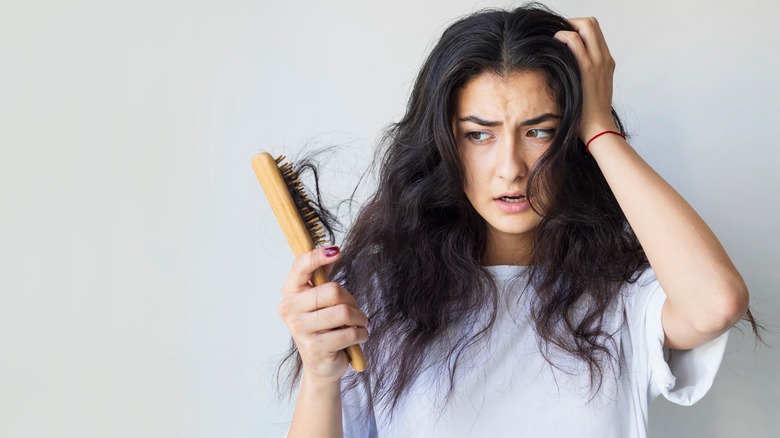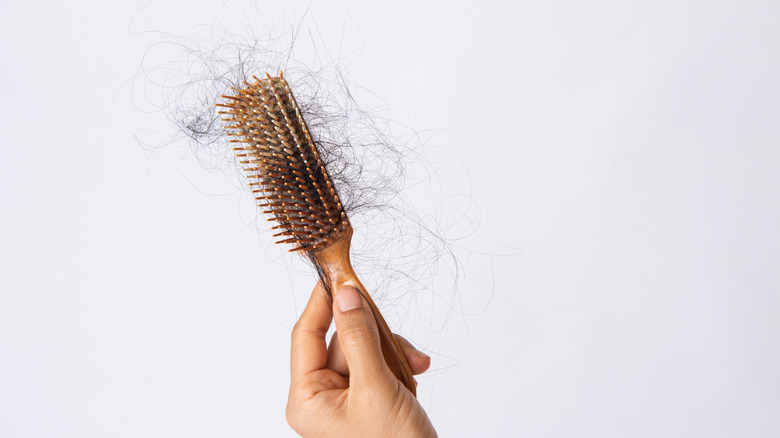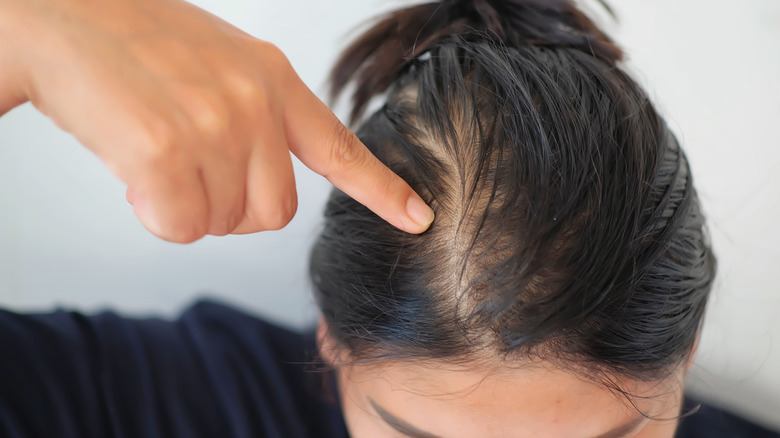What's A Normal Amount Of Hair To Lose In A Day?
As you are washing your hair or brushing it every day, you may begin to notice some hair loss. It might freak you out a little as you see the number of strands lost each time. However, some hair loss is perfectly normal. It's just a matter of keeping an eye on it and knowing the difference between what is normal and when you should be concerned (via Vedix).
"Light shedding is normal and part of the hair's life cycle," board-certified dermatologist and spokesperson for the Reflections of Alopecia Areata campaign, Dr. Amy McMichael, M.D., tells Martha Stewart. "You may see this type of hair shedding when you shower or brush your hair." In fact, it is fairly simple to gauge just how much hair loss you're experiencing and whether that falls under the normal spectrum. But hair loss can happen in a variety of ways for a variety of reasons, so it's important to pay attention to your hair and your body to get to know the process better.
What normal hair loss looks like
According to Healthline, hair is considered healthy when it has movement, volume, and shine, all of which can still be accompanied by hair loss and still be considered normal. Healthy hair loss makes hairs that may have already been loose or disconnected fallout, which are the ones you see near the drain during a shower or collecting in your hairbrush. The American Academy of Dermatology Association says that losing 50 to 100 strands of hair a day is normal. With nearly 100,000 hair follicles in each person's hair, losing about 100 strands a day is barely noticeable.
In fact, hair "shedding" is just a regular part of your hair cycle. "The growing stage is known as anagen, [which is where] 85% of our hair is in the cycle at one time; this can last up to six years," salon trichologist Penny James tells InStyle. The next stage, known as the catagen state, she explains, is when your hair is at its resting stage. The last stages, known as telogen and exogen, are when your hair naturally falls out in preparation for new growth.
However, many different factors can affect the way you lose hair. For example, women experience more hair loss than men. A study published in Dermatologic Therapy found that 40% of women experience hair loss due to how they style it with heated styling tools, hair dye, and something as simple as frequent hair brushing. Experiencing pregnancy or menopause can also create longer periods of hair shedding for women.
When to be concerned
The American Academy of Dermatologists warns that once hair loss passes the threshold of 50 to 100 hairs per day, you may be experiencing excessive hair loss. However, board-certified trichologist David Kingsley, F.W.T.S., tells Martha Stewart that it's important not to get too caught up in the numbers because everyone's health and hair experiences are different. "For instance, if you count your hair over a few weeks and notice that about an average of 90 hairs fall out, you might decide that this is okay because it fits nicely in the 'normal' range," Kingsley tells Martha Stewart. "However, if you were only losing 45 hairs per day [at one point], 90 is twice your normal average. This could mean that you have excessive hair loss." It's all about paying close attention to your body's regular cycles and knowing when something is off.
However, there are certainly signs to let you know when you are experiencing excessive hair loss. According to Mayo Clinic, you will start noticing a gradual thinning on the top of your hair, patchy bald spots, large clumps of hair loss, loose hair, body hair loss, or scaling and itching on your scalp. Other factors that could contribute to hair loss are stress or health conditions like alopecia, thyroid issues, lupus, nutritional deficiencies, and more (via Healthline). If it reaches this point, it's time to see a doctor for a treatment plan specific to your body and your individual hair loss experience.


